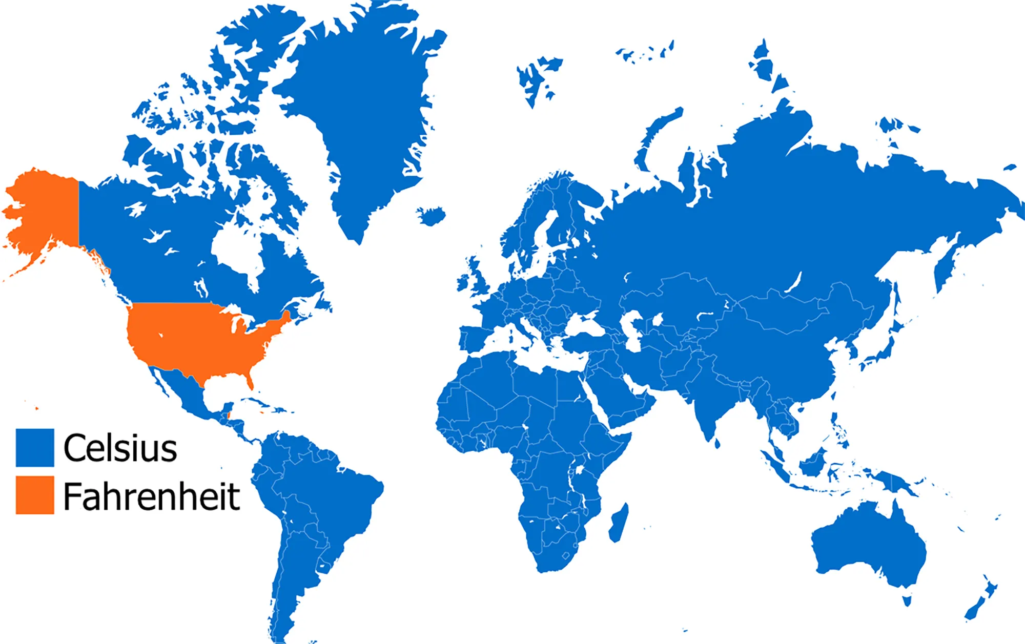
Americans continued to use Fahrenheit because people had the option to switch or no. This made the switch elective rather than forced and many individuals didn’t want to learn new temperature or weight systems.
Except for the United States, almost every country on the planet measures temperature in Celsius. This makes sense; Celsius is a sensible scale that gives the freezing and boiling temperatures of water with round values between zero and one hundred. In Fahrenheit, numbers are 32 and 212, respectively.
This isn’t simply a physical problem. America’s persistent refusal to leave Fahrenheit temperatures is part of the country’s overall ridiculous refusal to switch to the metric system, which has real-world consequences. A single conversion mistake between US and metric measurements led to the burning death of a $125 million NASA spacecraft in Mars’ atmosphere.
Fahrenheit was an excellent temperature measurement method 300 years ago
The Fahrenheit measurement method was really rather useful in the early 18th century. Daniel Gabriel Fahrenheit, a German physicist born in Poland in 1686, is credited with the invention.
Fahrenheit got interested in thermometers as a young guy. This may appear strange, but monitoring temperature was a major issue at the time. Nobody had devised a constant, dependable method of accurately measuring temperature.
As the creator of the thermometer as we know it, Fahrenheit had to put something on them to distinguish between different temperatures. The scale he chose became known as the Fahrenheit scale.
Fahrenheit set zero to the lowest temperature he could get using a water and salt combination. He then selected 96 degrees as the second fixed point in the system, based on a (very little inaccurate) assessment of the average human body temperature. The resultant schema established the boiling point of water at 212 degrees Fahrenheit and the freezing point at 32 degrees Fahrenheit.
Fahrenheit was admitted into the British Royal Society, the premier Western scientific institution at the time, in 1724, and his approach quickly spread throughout the British Empire.
As Britain conquered huge areas of the globe in the 18th and 19th centuries, it carried the Fahrenheit system (along with other odd Imperial measures like feet and ounces) with it. Fahrenheit became a common temperature across the world.
Why is it still used in America?
The Anglophone world turned out to be an exception. By the mid-twentieth century, most of the globe had adopted Celsius, the most widely used temperature measurement unit in the contemporary metric system. Anders Celsius, a Swedish astronomer, created the Celsius scale in 1742.
Around 1790, Celsius was incorporated into the metric system, which arose from the French Revolution’s goal to unify the country at the national level. The metric system’s simplicity and scientific value aided in its expansion, as did celsius.
In the second part of the twentieth century, the Anglophone countries eventually gave in. In 1965, the United Kingdom began metrication or the process of converting all measures to the metric system. Although it has not yet accomplished full metrication, the modern United Kingdom is largely metric.
Almost every other former British colony followed suit. Some did so before even the UK (for example, India), while others did so subsequently (e.g., Canada, Australia, South Africa). These changes, which occurred at around the same time, encouraged the United States to explore adopting the metric system.
It made it logical to move, both because the metric system is more obvious and because adopting the same system as other nations would greatly facilitate scientific cooperation. The 1975 Metric Conversion Law was implemented by Congress and was intended to kickstart the metrication process. It established a Metric Board to oversee the changeover.
The law failed miserably. The people had a large voice in the subject since it made metrication elective rather than forced. Many individuals also did not want to learn new temperature or weight systems.
“Motorists resisted the concept of highway signs in kilometres, weather watchers panicked at the possibility of reading a forecast in Celsius, and shoppers balked at the prospect of buying chickens by the kilogram,” Mother Jones’ Jason Zengerle writes. According to Zengerle, organized labor also opposed it so that workers would not have to retrain to understand the new measures.
In 1982, President Reagan dissolved the Metric Board, leaving its work in chaos. The law’s poor execution by Congress assured that America would continue to measure temperature in Fahrenheit.
Today, the United States is practically alone in the world in refusing to use the metric system, with only Burma and Liberia joining it (Burma announced its intent to metricate in 2013). I know it is easy to convert Celsius to Fahrenheit, and Fahrenheit to Celsius using a formula, but this will be time consuming.
By continuing to use Fahrenheit, the United States is causing itself unnecessary harm
The odd measures frequently employed in the United States, especially Fahrenheit, are harmful to the country’s scientific establishment, children, and, most likely, companies.
Susannah Locke makes a compelling argument for Celsius and the rest of the metric system, but here’s a quick refresher. Because metric scales are simpler, fundamental computations are easier and hence less error-prone. American businesses face additional expenses by creating two sets of products, one for the US and one for the rest of the world that uses metric measurements.
When giving out medicine, American parents and caregivers are more prone to make mistakes in conversion rates, sending certain children who are more susceptible to overdosing to the hospital. Furthermore, American students must be educated on two sets of measures, complicating basic scientific teaching even further.
So, while Daniel Fahrenheit did the world a favor by creating a dependable thermometer, his temperature-measuring method has outlived its usefulness. It’s time for America to embrace Celsius — and the rest of the metric system.





This article is very misleading. The US has adopted the metric system for many things, and is used extensively in science, medicine, electronics, the military, automobile production and repair, and international affairs. Post-1994 federal law also mandates most packaged consumer goods be labeled in both customary and metric units. Metrics has been the “preferred system of weights and measures for United States trade and commerce” since 1975. Yes, the citizenry prefer the old Imperial system of miles per hour for driving, or pounds for our weight, Farenheight over Celsius, and especially fee, inches and yards for thinking of distance, but the country as a whole is “mixed” on its usage, as is England, which only switched to the metric system in 1965. but also still uses miles and ounces. So your depiction of the US’s stupidity (at least in this instance) misses the truth by a mile.
a kilometer would make more sense.